WASTING AWAY IN MEXICO!!!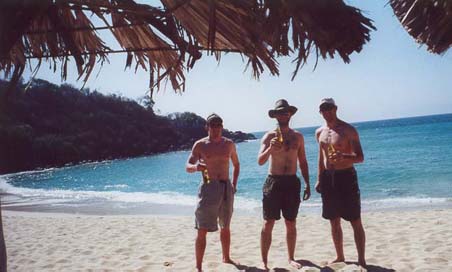
Noticing that school was due to start in a half week, brothers Rob and Jon and life long friend Dan promptly flew down to Mexico City to forget all about reality! Loaded down with 50 pound packs that they crammed full with everything but the trusty machete, due to the cramp down on security, they set out. There was only one planed task to complete during 2 1/2 week trip . . . to climb the 3rd tallest peak in North America. Pico de Orizaba towers above the surrounding flatland at an altitude of 18,700 ft. |
|
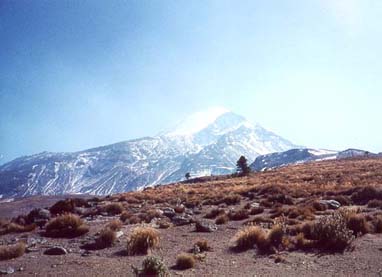 |
to get around with, the climbing team made it all the way to Tlachichuca the first day. The town lies between Puebla, south east of Mexico City, and Veracruz, a port city on the eastern coast. As with many of the bus rides taken this trip, musicians would liven up the drive by boarding the bus and playing a set or two before moving on and before we knew it we were there! |
The next day we took jeeps that dated back to WW2 up to the base camp of the volcano Pico de Orizaba at 14,000 ft. (it was starting to get annoying to write in the 3rd person) At base camp there were a couple of huts made of stone with many bunks for climbers to stay in before the accent. We chilled there that day and night drooling as we looked at the glacier capped peak. The picture to the right is taken from the base camp looking up at the route we would take to reach the peak. We hung out at base camp that day and the next pumping water and cooking up feast after feast to load up with energy before the climb. There were anywhere from 5 - 20 other mountaineers there either preparing to climb or returning from one. We were able to meet several great climbers including world renowned ice climber Berry and also world renowned mountaineer Craig Van Hoy who is a guide for Northwest Mountain Guides. He was part of the first american team to climb the world's 3rd tallest mountain Mt. Kangchenjunga and is planning a 3rd attempt on Mt. Everest after disappointingly turning back near the top due to weather. |
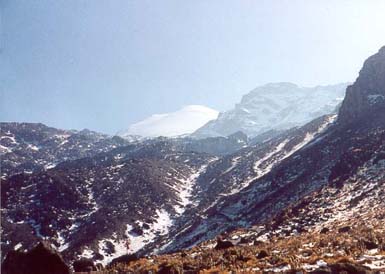
|
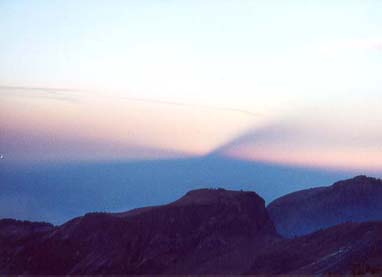
|
|
the sun would sink behind the peak. This casted a shadow of the peak down on the valley as it was filled with fog (seen to the left). The next day was gorgeous. There was not a cloud in the sky as we planned our climb. Feeling great, we strapped on the crampons and ice axes and climbed up to 16,500 ft to acclimatize. It was such a beautiful day that we were in short sleeves as we scouted the route through the cliffs for the final assent. When we made it back to base camp we packed away a few thousand more calories, topped off the water bottles and laid down to try to get some sleep. It was hard to come by as I had been fighting off a cold since before we left the States and some wicked wind had picked up. It sounded like it the gusts would take off the roof of the hut as we tossed and turned all night. |
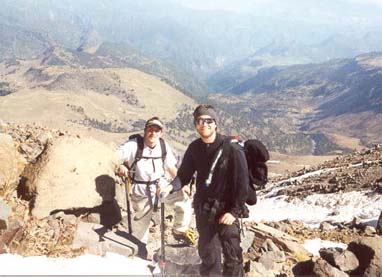
|
|
To our surprise the sky was clear except for a couple obscured stars right above the peak . . . We thought the stars were being blocked by some wispy high altitude clouds since we saw similar clouds off and the day before. The wind was very gusty however, and threatened to blow us over if we were not braced for it. It took much agility and quick thinking to piss down wind, as the wind direction keep changing! This kept us guessing as to which direction a storm would be coming from if it was moving with the wind. |
|
the wind and make a run for the peak. After we had one last meal of oatmeal and hot chocolate we bundled up and headed up at 2am hoping to be on the summit for sunrise. As we headed up we saw headlamps shine out above and below us, signs of other teams trying to climb that night. Unfortunately, as we rose higher the weather worsened and blowing snow started to kick up and reduce visibility. After navigating through some couloirs (ice and snow chutes between rocks) we reached the base of the glacier at 16,500 to find that we had overtaken the other climbing teams. Battling against the wind, we pushed our way up the glacier kicking our crampons into ice that was the consistency styrofoam. Once on the glacier visibility was about 5 ft and it was necessary to shout to hear each other over the brutal wind. |

|
|
since it is a dormant volcano. However, it does have a steeper side that goes to the highest point on the volcano rim. We climbed up this steeper side since we did not want to wander around the crater rim in the dark. |
|
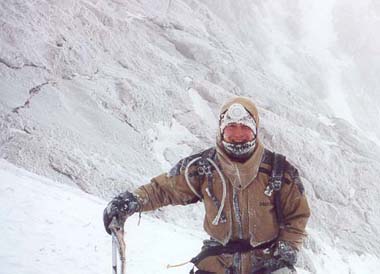 |
the tinted goggles to protect our faces from the weather. Our eyelids wanted to freeze shut every time we blinked and our eyes and our "beards" that we grew out to block the wind were entirely encrusted with ice. The cold got through one of my boots and a few toes went numb half way up the glacier. Other than that we all felt warm and strong . . . at least that's what we kept telling each other. After almost turning back a couple of times we finally came to a point where the slope began to pitch over and get less steep. We decided to stop there since we heard stories of people who don't stop hiking and end up falling into the center of the volcano. There would not have been able to see anything anyway since it was pitch dark and visibility was still at 5 ft. So feeling confident that we had successfully conquered the mountain in some of the worse conditions possible we headed down at about 7 am. |
We were relieved to finally head down, ending the endless trek up the dark and fierce mountain . . . but as it was the end of the climb it was the beginning of the adventure! Taking out the compass I took a baring (directly south) to head back to camp because the snow erased all trace of our ascent. In the process I was forced to take my hand out of its warm and humid glove. It was unbelievable, my hand almost instantly froze stiff and it took several minutes to thaw back out inside the glove. So we headed down, but soon came down on some crevasses, cracks in the ice that can get up to hundreds of feet deep. These were only inches wide but the terrain was very icy in the area and we could hear the ice creaking. Remembering the day before looking at the peak from base camp with binoculars, we saw crevasses on the southwest side of the glacier so we decided to keep the crevasses on our left side. After down climbing for hours, visibility became a little better ~30 meters as it got lighter out. We came upon the base of the glacier, however none of it looked familiar. It turned out that the wind had pushed us so that we were climbing down the east side of the Orizaba and we had come upon a different set of crevasses and unfortunately used our instincts over the compass. We were too tired to climb up and did not want to traverse the icy and unstable crevasses so we decided to navigate down some couloirs around some serious cliffs and find out where we were after we got out of the storm. |
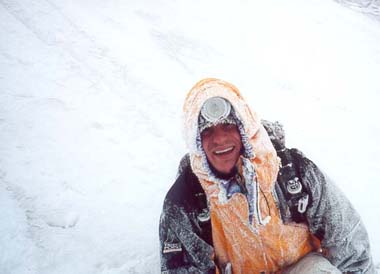
|
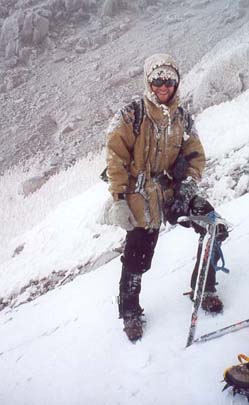 |
After dropping below the cliffs at about 10am the storm lightened up and we finally stopped to drink the little of our water that was not frozen and eat a little. Before this time we would get very cold if we stopped moving for even the shortest amount of time. But, we were able to tuck behind some boulders and find shelter from the elements for a while. We continued heading down and every once in a while the clouds would clear and we were able to take a bearing on a town we saw about 40 miles away below the mountain. We had to start shedding layers quickly as we moved down into the warm valley as we hiked through the hills and trees at about 10,000 ft. Luckily, we eventually came upon some goat herders there in the middle of the forest! Looking at us strangely they pointed out a path that would take us to a town that was on the road to the base camp. So we headed to the town, which was about 20 miles away with the little energy we had left. We finally reached it with non-stop hiking until 4:00pm. We wanted to get back as quick as possible to prevent people worrying about us and sending anyone up after us. At the town we were able to flag down some climbers who were driving up to base camp and they gave us a ride back up into the storm. When we got back to base camp the jeep was there to bring us back down to town so we quickly packed up. Talking to other people there we came to find out that everyone else turned back that night and that if we had not got back in another 2 hours these Mexican Red Cross mountaineers were going to go searching for us. |
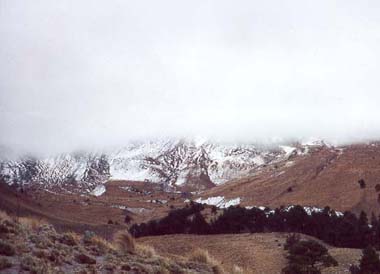
The Red Cross guys actually came down off the mountain with us as they were heading home and we became good friends. They ended up offering to bring us down to their city of Oaxaca, which is directly east of Acapulco. After leaving the mountain it was beautiful, hot weather as expected. |
|
 |
and the next day piled into the back of their truck and had a 5 hour drive south. When we arrived Orizaba one of the guys, Mario, invited us to stay with him and his girl friend Hilda (his daughter is also with them on the left). They were very kind and gave us rooms to stay in their house, cooked 3 meals a day for us, and gave us a great insight to there culture and history. It seemed like Mario knew every brick in the city and, to our delight, was intent on explaining each one to us in detail. Even though Hilda was going to school, it seemed like she was at home at the perfect time to cook up a feast! Some highlights were the mole negro (chocolate) with chicken, mole verde, mole amarillo, chili quiles, and Oaxacan string cheese. |

|
|
days off work and showed us all around the city. We saw several museums, churches, cultural centers, and the Zapotec and Mixtec ruins (which began ~500BC) of Yagul, Mitla, and Mounte Alban with their tombs, carvings, pillars, ball courts, and pyramids. The ruins of Mitla (seen with some of the original red stucco) was a very sacred place. Mainly priests stayed here and several tombs were built beneath the structures. The structures at Mitla were special as their roofs were independent from the walls. This allowed the roofs to move during an earthquake and prevent the destruction of the structures! The ruins of Yagul, seen on the right, was a city that watched over the intersection of several valleys. From on top of the hill the people could control the trade of people who passed through. Mounte Alban, seen on the left, was the ancient Zapotec capital that stands at the top of a flattened hilltop. The temples and partial pillars that covered the peak were very impressive as they watch over the present day city of Oaxaca. Mario would drive us all around the city showing us places the guide book did not even mention. |
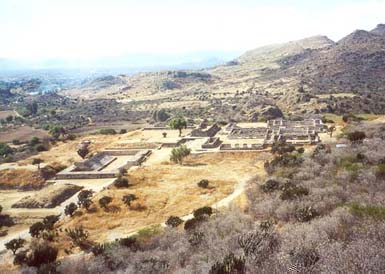
|
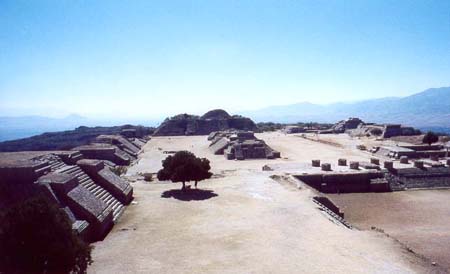 |
that we wanted to buy as souvenirs and he would say "no, no, no, let me take you to where they actually make this". So we saw the rug makers make dye and weave rugs. At one house a guy showed us how he makes crimson dye on Rob's palm! He took some powder, which was made from grinding up a certain bug, water, salt, and lemon juice and mixed it up in his hand and it turned a bright crimson color. Not only does it dye wool well, but it also dyed Rob's hand for several day pretty well. Next, we were taken to where people make the black and green Oaxacan pottery and finally to where people hand carve and paint animals from wood. |
there for 3 days and took only day packs to tour around southern Mexico by bus. We would take night busses from city to city staying in towns only a day so we did not have to pay for a place to sleep. It was great as it allowed us to see a lot, but sleeping on busses guided by drivers that had death wishes got old. |
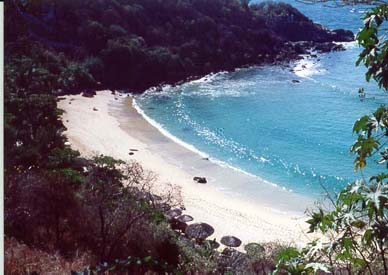
|
 |
of Puerto Escondido. It is like a non-touristy Acapulco. We had some great sea food and chilled on a deserted beach, that is deserted until about 2:00, when the locals joined us. There were cabanas on the beach where you could by ice cold Corona and fresh coconuts. Unfortunately we were not able to do any snorkeling or scuba diving on this trip, but the crabs and fish in the tide pools weren't too shabby! The warm sunshine and palm trees were quite an amazing contrast to climbing in the blizzard only a few days before. |
That night we traveled east to Tuxtla, the capital of Chiapas. We stayed there a couple days touring around. One day we saw the very bright and colorful Fiesta de Enero at town of Chiapa de Corzo. While we were there we took a boat ride up the Canon Del Sumidero on the river Rio Grijalva, which was rimmed with high canyon walls and rain forest. Along with colorful birds there were wild crocodiles and monkeys. The next night we took a bus to San Cristobal de las Casas. This town had a great atmosphere and we spent all day checking out the markets, museums, and historical sights. About 9 different groups of Mayan decedents live in the areas around the town and they come in to trade at the markets. The town is also close to Guatemala so we spent a bit of time tasting the locally grown coffee. We actually saw some Zapatistas driving around with their face masks looking very menacing. The Zapatistas was a group that overthrew the government in several cities including San Cristobal and brutally fought the Mexican government in '94. |

|
|
From here we went deeper into the forest to the ruins of Palenque. The Palenque ruins are said to be some of the best ruins in the world and are definitely the best intact Mayan ruins(~600AD). |
|
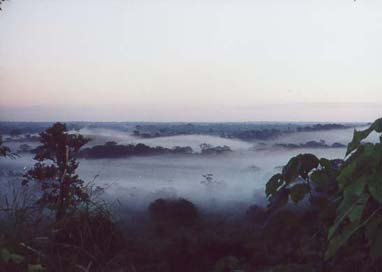 |
500 with some reconstructed, but most were overgrown. The structures including pyramids, a ball court, and a aqueduct were completely jungle enshrouded and the morning mist gave it a real wild feel. We were able to get off the beaten path and do some exploring for a while . . . that is until we ran in to gorillas! Actually it was an armed guard that told us that there really were gorillas that rob hikers if they get far off the path. In our exploration of the forest we found some long over grown ruins and with our headlights checked out their tombs. It was very Indiana Jonesesk, especially with the bats and lizards! We also found veins again and swung on them through the foliage for a bit . . . it's only natural! Next, we came upon a natural pool with a nice water fall coming into it. So we played in the water for a while jumping off the falls into the pool. It was quite a relief as we were able to wash off all the weird stuff that got on us while hiking through the forest. We did get bitten up a bit by mosquitos that day, but as of yet no one has come down with yellow fever yet! |
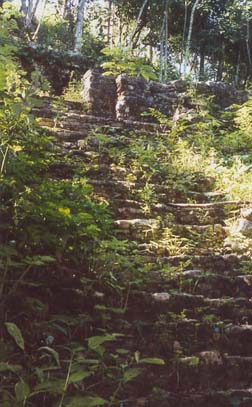 |
 |
and stayed another day with Mario and got our gear. We then bussed back to Mexico City to check out the huge city. We stayed there another 4 days checking out art and anthropology museums, markets, and squares. |

|
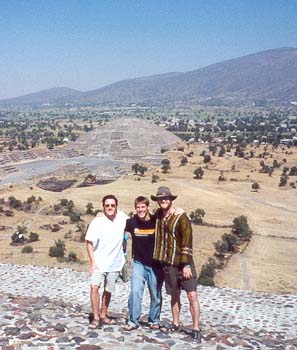
|
|
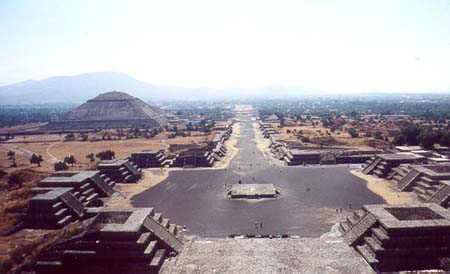 |
and pyramids at Teotihuacan, which were built around 100AD long before the Aztecs who came along in the 14th century. We found the culture at each city unique and colorful. We went to food and craft markets in every town and found things we could hardly imagine. Everything from tuna ice cream to roasted grasshoppers . . . actually tuna is a type of fruit. But, we did bring some of the grasshoppers back, don't tell customs, gave them a re-bake in salt and lime, and put them out for snakage at a party I recently had. Surprisingly about 30% of the people tried them and about 10% came back for more of the long legged loven! Maybe we would have had better results if my roommate and I did not make homemade salsa and cookies . . . |
was fresh and spicy. They had fresh fruit of every kind and we just about overdosed on avocados squeezed into fresh hand made corn tortillas. The fresh bread that we was available on just about every street corner of every town was amazing, we could not get enough of it. We even got fresh chocolate! Check this, we went into this chocolate shop and they asked what we wanted in our chocolate. After you order they start grinding the cocoa beans up and due to natural oils it turns into a peanut butter type consistency. They then add sugar to the chocolate and mix it. This produces a chemical reaction and the chocolate heats up really hot. You then throw in what ever else you like: milk, cinnamon, almonds, coffee beans, whatever, and they mix it all up. They end up giving you a plastic zip lock bag with this hot peanut butter like chocolate. We then took it back to Mario's and formed the chocolate into all sorts of shapes and let them sit and cool overnight and we had chocolate pieces in the morning! |

|
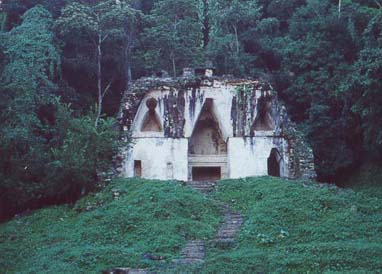 |
If you would like to see any other pictures of specific parts of the trip, or want higher resolution copies of what are on the web site, just let me know. Also, don't hesitate to ask if you have any questions about Mexico, it is a wonderful experience. jon.pineau@colorado.edu Check out some pictures from other trips here |